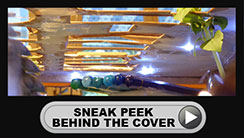
By Tara Lissner, Swiss Gardening School
Well, we’ve had snow, sunshine and rain and with the time change this weekend it really is beginning to feel like spring. I’m enjoying the flashes of colourful bulbs in bloom everywhere I go with the scent of hyacinths heady in the air, the garden filled with birds chirping before dawn and the massive bumble bees defying gravity with their flying skills – it feels like spring.
With this change in seasons comes that irresistible urge to get back to the garden, long gone are the lazy afternoons with gardening books open for inspiration, now is the time to work.
I spent hours outside this past weekend fixing up the vegetable plot, assessing the state of the compost bins (I have four), trimming back errant rose branches and carefully clearing out the perennial border. I also had some time with my mulch. I love mulch – a curious statement perhaps but not when you realize what magic it works. I keep a large bin of leaf mould and once decayed, after at least a year, I spread it on beds in the garden which need an improved soil structure, perhaps areas where I’ve noticed the beds drying out in the summer. Leaf mould does not bring much in the way of nutritional value to the soil however it really does improve the structure. By adding a layer of at least 6cms to the earth, weed growth is discouraged, humidity is retained and the insects do all the work by working the leaf mould into the soil. I use well composted garden material as mulch in areas like the vegetable plot and perennial beds where I want to add nutritional value as well as improving the soil structure.
I planted a green manure of spinach this winter in two of my raised vegetable beds and this weekend turned them into the soil – I’ll wait another couple of weeks before I plant something in them. My herb bed is showing signs of life with the tarragon coming along nicely and the unstoppable chives reaching for the sky. I’ll be moving the beans into a new position this year and have just moved the structure that they will climb up from one bed to another – now all I have to do is choose a variety. We have had snow over the Easter break in the past so if you are thinking of sowing vegetable seeds directly now do consider buying some fleece to protect your young seedlings – better safe than sorry.
With this improving weather comes the joy of pests. The two big ones at this time of year are of course the processional caterpillar and the box wood caterpillar. You may have noticed the white cocoons high in the branches of conifer trees, the home to the processional caterpillar. These caterpillars will now begin to leave their white cocoons and march down the tree on the next part of their journey wherever that may take them. The cocoons are easily spotted and should have been removed by homeowners (and destroyed by burning) before the end of February. The long hairs on the caterpillars and within the cocoons are very poisonous to young children and domestic animals provoking an allergic reaction which can be quite impressive. If the caterpillars are ingested by your dog or cat head directly to the vet. If you see cocoons in your garden give your commune a call and they will direct you how best to have them removed. They may also fine you!
The next favourite of this early season is the box wood caterpillar. This small green and yellow caterpillar can cause havoc with your box wood hedges and shrubs. First identified in Switzerland in 2007 it has now really taken hold and with a winter as mild as our most recent one it is likely that it will soon reappear. Look out for small white webbed cocoons, they house the young caterpillars which will hatch and begin eating. The effect can be devastating over a period of only a few days as these caterpillars have a huge appetite and to add insult to injury there can be three full reproductive cycles between April and October. Unfortunately there is no natural predator to reduce the numbers of caterpillars, they seem to be not attractive to birds. When I see the webbing I squash it, when I see the caterpillars I hand pick them from the box and I squash them too. One of the most effective natural drenches against this “Pyrale des Buis” is called Delfin and is made by Andermatt Biogarten in Grossdietwil, near Luzern. The product must be sprayed as soon as the caterpillars are seen, then again 12 days later and possibly once again during the growing season. The website has a wonderful gallery of close up photographs of these pests, perfect in aiding with their identification. You can mail-order their products directly from the website: Andermatt Biogarten
Now for something a little less devastating.
Garden centres are now filled with walls of little packets of seeds. Such a tremendous choice, everything from round courgettes to cherry tomatoes. If you have the space this is an ideal time to gently get started on growing your own vegetables. There are a few things to consider first; what are your summer plans, will you be away for five weeks on the trot? Will you be here with a houseful of guests to feed? Or, will you be home and away for short periods? These questions will allow you to best manage what you grow. While I love to have home grown salad, tomatoes and vegetables over the holidays I do not like to come home to an overgrown plot with hours of work ahead of me to rescue the green beans. Be realistic about what you grow and when you will harvest. Identify a teenager who could water and maybe weed a little during your absence and pay them. Then head back to the garden centre and start making your choices.
With magnolias about to burst into flower and the cherry blossoms floating like puffs of pink clouds get out and take a moment to enjoy them. Their ephemeral magnificence will soon pass and within a few weeks they will be covered in green leaves and we will forget about their beauty until next year.
What's on
Conservatoire & Jardin botanique de Genève
The botanical gardens of Geneva celebrate their bi-centenary this year with an extensive program of events. The website is packed with information on weekly events and special exhibitions to mark the occasion.
Conservatoire & Jardin botanique de Genève
Fête de la Tulipe, Morges, 1 April - 14 May
We know spring has arrived when the tulips in Morges start their fabulous display. The Parc de l'independence along the lake is packed with a very impressive display of a large variety of tulips. See the website below for a long list of activities in parallel to the tulip display. As always the tulips are dug up and sold to the public at the end of the season, this year Wednesday 17 May is the date for your diary.
Fête de la Tulipe
Le Jardin des cinq sens, Yvoire, 14 April - 8 October
The beautifully restored walled garden reopens to the public next month. A visit to Yvoire is never complete without a stroll through this magical garden. A garden themed quiz is available to accompany your visit; a children's version also exists.
Le jardin des cinq sens
Journées des Plantes au Lac d'Aiguebelette, 15 & 16 April, 10h-19h
Only 10 kms from Chambéry this bi-annual plant markets brings exhibitors from all over France. The perfect place to see something different in a stunning location.
Journées des Plantes au Lac d'Aiguebelette
Fête de Printemps, Schilliger Garden Centre, Gland, 22 & 23 April, 09h-18h
The greenhouses of Schilliger in Gland will be open to the public during there spring festival. Explore their production site and discover how they grow so many plants behind the scenes. Their gland centre is open seven days a week until 5 June.
Schilliger
Les Bucolique, Abbaye de Salaz, Ollon, 28-30 April
In the hills above Aigle and in the grounds of a beautiful abbey this event gets better every year. A long list of exhibitors from all over Switzerland enjoy this intimate location as the kick-off of the outdoor markets.
Les Bucoliques
Jardi Troc, Troc des Plantes, Grand Saconnex, 29 April, 13h-17h
This association of Geneva gardeners hosts their annual plant swap in Grand Saconnex. Open to all - bring your extra plants and swap them for something you need or just buy what is on show.
Jardi Troc
Author's bio

An enthusiastic, self-taught gardener, Tara Lissner is passionate about gardening and eager to share her zeal and knowledge with other gardening fans.
In 2012, she joined forces with Hester Macdonald, a British-trained landscape designer, to launch the Swiss Gardening School.
(Photo by Jean-Luc Pasquier)
Swiss Gardening School
www.swissgardeningschool.com








